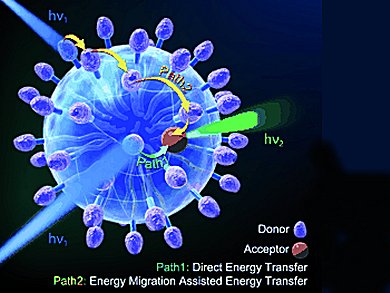Qing-Zheng Yang, Chinese Academy of Sciences, Beijing, Quing-Xiao Tong, Shantou University, Guangdong, all China, and colleagues report a biomimetic approach to construct artificial light-harvesting systems. They combined two self-assembling strategies (micellization and electrostatic attraction) and covalent fixation to prepare a highly efficient antenna system from readily available building blocks.
The synthesis was achieved by a one-pot reaction at RT. The modularity of the preparation makes it straightforward to vary the donor, the acceptor, and the ratio between the two. A high density of the antenna chromophore was achieved without self-quenching and excimer formation, affording extremely efficient energy transfer.
As the construction of the light-harvesting system is considerably simpler compared to most of those reported in the literature, it is a potentially useful platform for optical, photovoltaic, or photocatalytic devices.
Image: ©: Wiley-VCH
- Artificial Light-Harvesting System Based on Multifunctional Surface-Cross-Linked Micelles,
Hui-Qing Peng, Yu-Zhe Chen, Yan Zhao, Qing-Zheng Yang, Li-Zhu Wu, Chen-Ho Tung, Li-Ping Zhang, Qing-Xiao Tong,
Angew. Chem. Int. Ed. 2012.
DOI: 10.1002/anie.201107723




